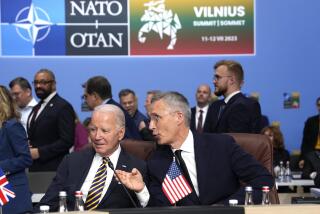Nonaligned Group Ripens and Matures
- Share via
In the long history of our planet there have never been so many countries or so few empires. This must be regarded as serious progress, even if many feel deafened by the cacophony of sound, much of it criticism, at the United Nations or at the periodic meetings when the Third World nations meet as they will next week at the nonaligned summit in Zimbabwe.
What stands out above the hubbub is that 170 countries do manage to exist cheek by jowl most of the time, and by and large they do make use of international meetings to talk over their problems rather than fight them out. Since World War II there have been more than 30 wars. But compared with 18th- and 19th-Century Europe, never mind the rest of the world, this is quite a modest scorecard.
Moreover, while the great empires did impose a pax of sorts in their respective domains, the envy created by the British Empire led to the two most devastating wars in history.
The nonaligned group, created in the 1950s by the great leaders of the postwar independence movement--Nehru, Tito, Nasser and Sukarno--was seen above all as a way of keeping the peace by offering the Third World nations a focus for alignment (each other) rather than feeling compelled to line up either with the super-powers or with their former metropolitan powers. Their vision has never been realized. Nevertheless, when they go to meetings like this and look in the mirror they can see that as a bloc they count for something, independent of the great powers.
One side of the nonaligned movement has been a thorn to the West, full of what Sen. Daniel Patrick Moynihan (D-N.Y.) has called “totalitarian language”--condemning the West for all its faults: economic hegemony, supporting Israel and South Africa and wasting funds on the arms race.
The Soviet invasion of Afghanistan radically changed their attitude. A movement that had thrived on using the Soviet Union to bash the West was thrown off balance by Moscow’s obvious blatant disregard for the sovereign border of a fellow Third World nation.
The change was profound. The Africans stopped being party to the traditional anti-Zionist resolutions. Cuba had to withdraw its candidature for a seat on the Security Council. Yet only a year before, under Cuban chairmanship at the nonaligned summit in Havana, carefully prepared, sharply barbed anti-Western resolutions were being passed by the dozen.
At the last meeting of the nonaligned--in March, 1983, in New Delhi under the chairmanship of Indira Gandhi--the tone could not have been more different from Havana. Gandhi herself epitomized the changing mood. When she had been prime minister before, she had been continuously at loggerheads with President Richard M. Nixon. Now in power again, dealing with Ronald Reagan, she made a supreme effort to be reasonable and friendly.
Some of the old issues of discord seem to have drifted away. The Third World’s effort to impose some undefined, deadening economic superstructure on the world’s banking and trading system is now on the back burner. So is Israel. Yet South Africa is very much alive and, with the meeting being chaired by Zimbabwe, is going to be the No. 1 topic of discussion next week.
But even on this emotive issue the Soviets find it hard to get a foothold. Rhodesia became Zimbabwe after a 10-year guerrilla war. Despite the bitter passions raised by the conflict, the Africans made it difficult for Moscow to maneuver. They made it clear that they preferred Western initiatives to break the deadlock. This was true in Namibia (South-West Africa) as well, and it seems to be true in South Africa.
The West is seen as less monolithic than it once was. If President Reagan and British Prime Minister Margaret Thatcher appear hostile, many of the nonaligned nations now realize that the U.S. Congress or other Cabinet ministers in Thatcher’s government may not be. Also, they realize that Australia, Canada and some of the Western European countries can be usedto bring countervailing pressure to soften the intransigence of the Reagan-Thatcher axis.
The nonaligned movement is maturing and ripening, yet the Western world has been slow to understand and come to grips with its chemistry. Most of the Third World will never want to get too close to the West, even if their interests were better served that way. They are all nationalistic, all proud, all wanting to be different and sing their own tunes.
We have to give them room to stretch, and we shall bask in the fact that within the last 40 years nearly 100 new countries have been born, the great old empires have died and an increasing number of nonaligned nations take their nonalignment seriously. With this in mind, we can tune in to the inevitable words of criticism aired by the voices gathered in Zimbabwe, listen when they are wise and ignore them when they are foolish.
This is the world that we inhabit. They are the majority. We have the military and economic power. It is an uneasy balance, but it’s going along better than anyone had a right to expect.
More to Read
Sign up for Essential California
The most important California stories and recommendations in your inbox every morning.
You may occasionally receive promotional content from the Los Angeles Times.









